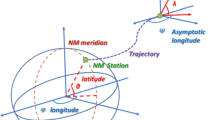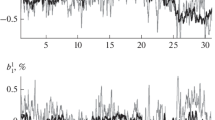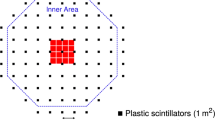Abstract
A new variant of a global survey method that allows obtaining information on the first two angular moments of cosmic ray distribution function in the interplanetary space using the data of continuous hourly registration of muon telescopes of the GMDN network and the Yakutsk cosmic ray spectrograph is presented. A calculation of receiving characteristics for the telescopes and accounting of the temperature effect that are necessary for a successful realization of the method are carried out. The results of application of the method in definition of cosmic ray anisotropy parameters are analyzed for the period 2012–2018.
Similar content being viewed by others
References
A. M. Altukhov, G. F. Krymsky, and A. I. Kuzmin, in Proceedings of the 11th ICRC, Budapest, 1969, Vol. 4, p. 457.
K. Nagashima, Rep. Ionos. Space Res. Jpn 25, 189 (1971).
A. V. Belov, E. A. Eroshenko, V. G. Yanke, V. A. Oleneva, M. A. Abunina, and A. A. Abunin, Geomag. Aeron. 58, 356 (2018).
V. M. Dvornikov, V. E. Sdobnov, and A. V. Sergeev, in Collection of Articles “Variations of Cosmic Rays and Investigation of Space” (IZMIRAN, Moscow, 1986), p. 232 [in Russian].
http://cosray.shinshu-u.ac.jp/crest/DB/Public/Archives/GMDN.php.
G. F. Krymsky, A. I. Kuzmin, P. A. Krivoshapkin, I. S. Samsonov, G. V. Skripin, I. A. Transky, and N. P. Chirkov, Cosmic Rays and Solar Wind (Novosibirsk, Nauka, 1981) [in Russian].
L. I. Dorman, Variations of Cosmic Rays (Gostehizdat, Moscow, 1957) [in Russian].
A. I. Kuzmin, Variations of Cosmic Rays and Solar Activity (Nauka, Moscow, 1968) [in Russian].
K. Fujimoto, K. Murakami, I. Kondo, and K. Nagashima, in Proceeding of the 15th International Cosmic Ray Conference, Plovdiv, 1977, Ed. by C. Ya. Christov (Institute for Nuclear Research, Bulgarian Academy of Sciences, Sofia, 1977), Vol. 4, p. 321.
http://cosray.shinshu-u.ac.jp/crest/DB/Documents/documents.php.
L. I. Dorman, V. S. Smirnov, and M. I. Tyasto, Cosmic Rays in the Earth’s Magnetic Field (Nauka, Moscow, 1971) [in Russian].
M. D. Berkova, V. G. Grigoryev, M. S. Preobrazhensky, A. S. Zverev, and V. G. Yanke, Phys. At. Nucl. 81, 776 (2018).
G. F. Krymsky, Modulation of Cosmic Rays in Interplanetary Space (Nauka, Moscow, 1969) [in Russian].
Acknowledgments
The work is carried out under the support of the Russian Foundation for Basic Research project no. 18-02-00451-a. This study was performed on equipment at the unique research facility of the Russian National Network of Cosmic Ray Stations. Also, we gratefully thanks the authors of NMDB, MDDB, and GMDN databases for providing their data.
Author information
Authors and Affiliations
Corresponding author
Rights and permissions
About this article
Cite this article
Grigoryev, V.G., Gololobov, P.Y., Krivoshapkin, P.A. et al. Method of Global Survey by Data of Muon Telescopes. Phys. Atom. Nuclei 82, 879–885 (2019). https://doi.org/10.1134/S1063778819660220
Received:
Revised:
Accepted:
Published:
Issue Date:
DOI: https://doi.org/10.1134/S1063778819660220




